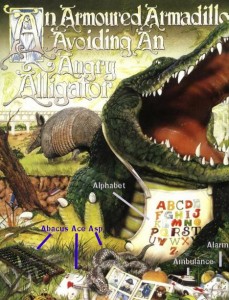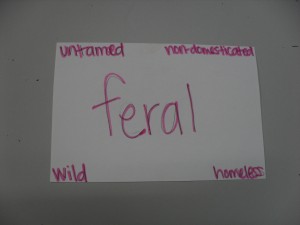Today is one of my favorite days: teaching the three literary elements from Beowulf!
First, we talked about alliteration. The bards used alliteration when telling their stories to help with memory: it was a mnemonic device.
We started out by doing a word search – I put you in partners and gave you a picture from the book Animalia. If you had the letter A, you and your buddy wrote down as many A letters down inside the letter that you could.
As you can see from this examples, all of the drawings in this picture start with the letter A. Afterwards, we wrote a ten word alliterative sentence. If you had C, you wrote ONE sentence that MAKES SENSE that has AT LEAST TEN (school appropriate) C WORDS.
Think of it this way: start out with a base sentence, like:
Ellen Eves entered the east entrance.
That’s only five E words, so I need to add more.
Think of an adjective for Ellen, like this:
Energetic Ellen Eves entered the east entrance.
Look at your verb. Think of an adverb that can describe HOW your verb happened.
Energetic Ellen Eves eagerly entered the east entrance.
Still short? Try adding adjectives such as colors and numbers.
Energetic Ellen Eves eagerly entered the east entrance eight times.
Energetic Ellen Eves, when she was only eighteen, eagerly entered the east entrance eight times.
Nine Words! This is where I suggest going to the dictionary to find an E word that you can incorporate and using PREPOSITIONAL PHRASES.
Energetic Ellen Eves, when she was only eighteen, eagerly entered the east entrance eight times with an entourage after the examination.
Then, we listened to The Breaks and watched me dance crazily around the room. You kinda missed the show here, but I was demonstrating caesuras.
What you need to do with the file in Schoology, write is use the following four words around the word CAESURAS in the four corners: pause, suspense, comma, break.
On the next slide, write a definition for caesuras using those four words. Ask a crew member for help if you need it. ![]()
Then, we worked on kennings. A kenning is pretty much just a compound nickname. The Anglo-Saxons used them, so to understand the bards, we need a little nickname practice. Go to Schoology > Beowulf > Before We Read and find the kenning assignment. If you look at Kennings slide show, you’ll see memes that other people did about animals and musical instruments. Note they focus on what the animal LOOKS like or DOES. The also don’t rename the name of the animal. For example, it’s not a TRASH RACCOON because it IS a raccoon!
MAKE sure that you are using a COMPOUND NICKNAME. You have to replace “Look at that raccoon”with “Look at that TRASH PANDA“.
I will take the Memeing Kennings activity as a grade.


